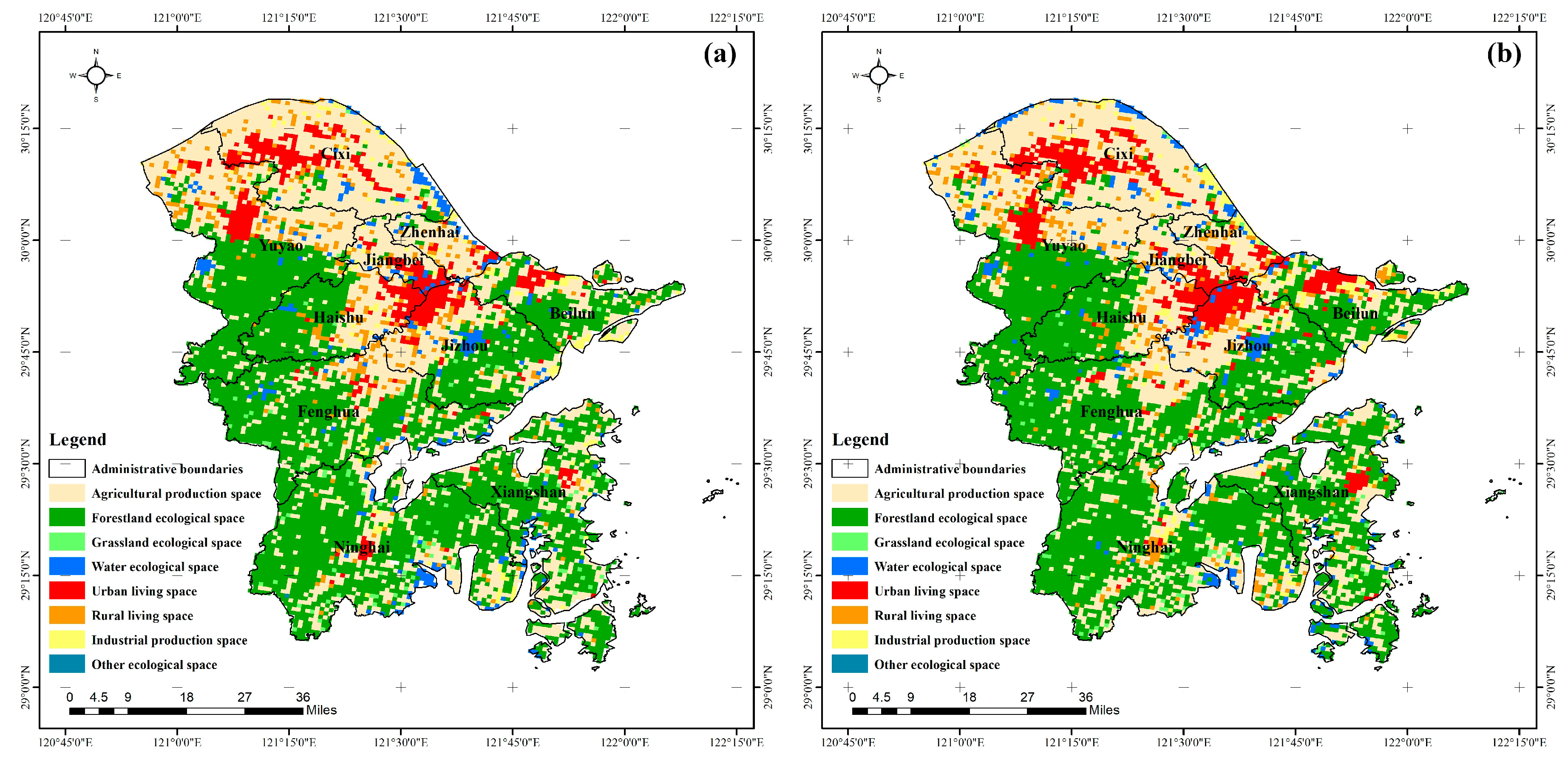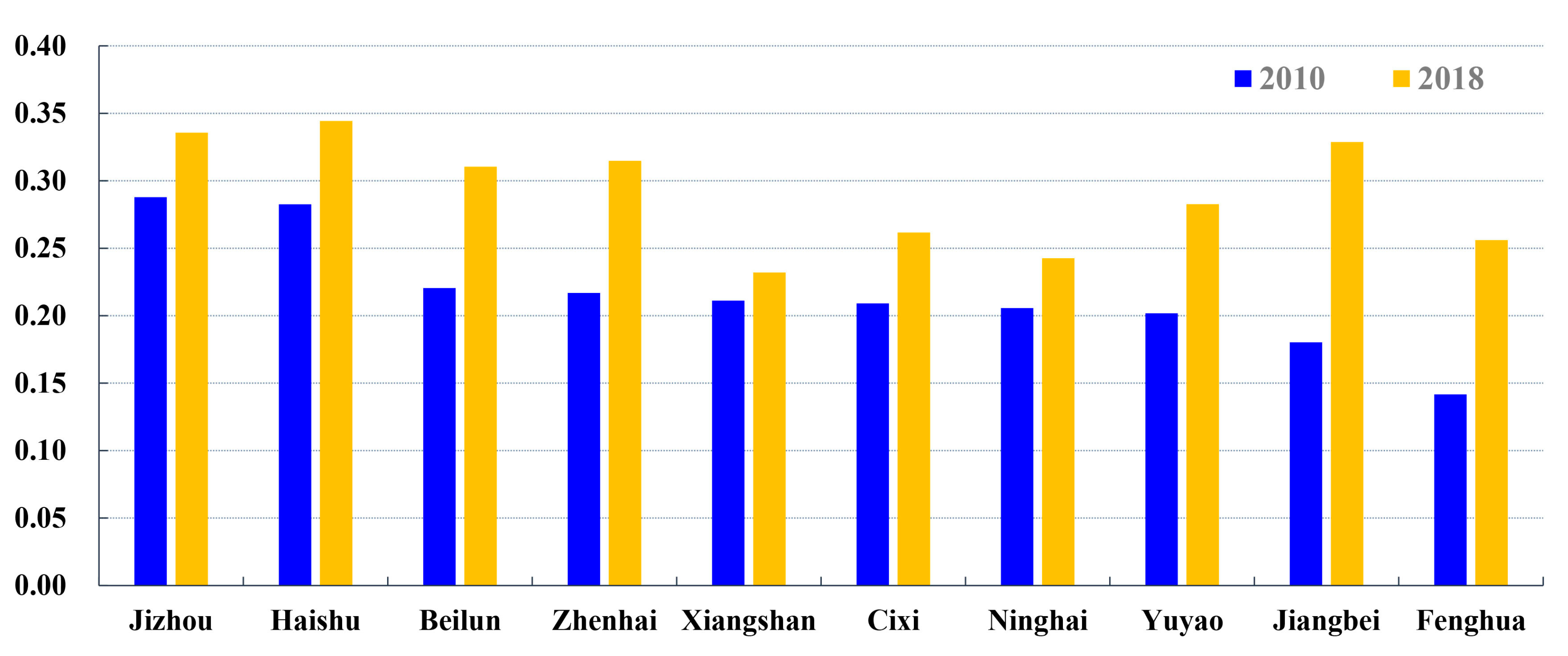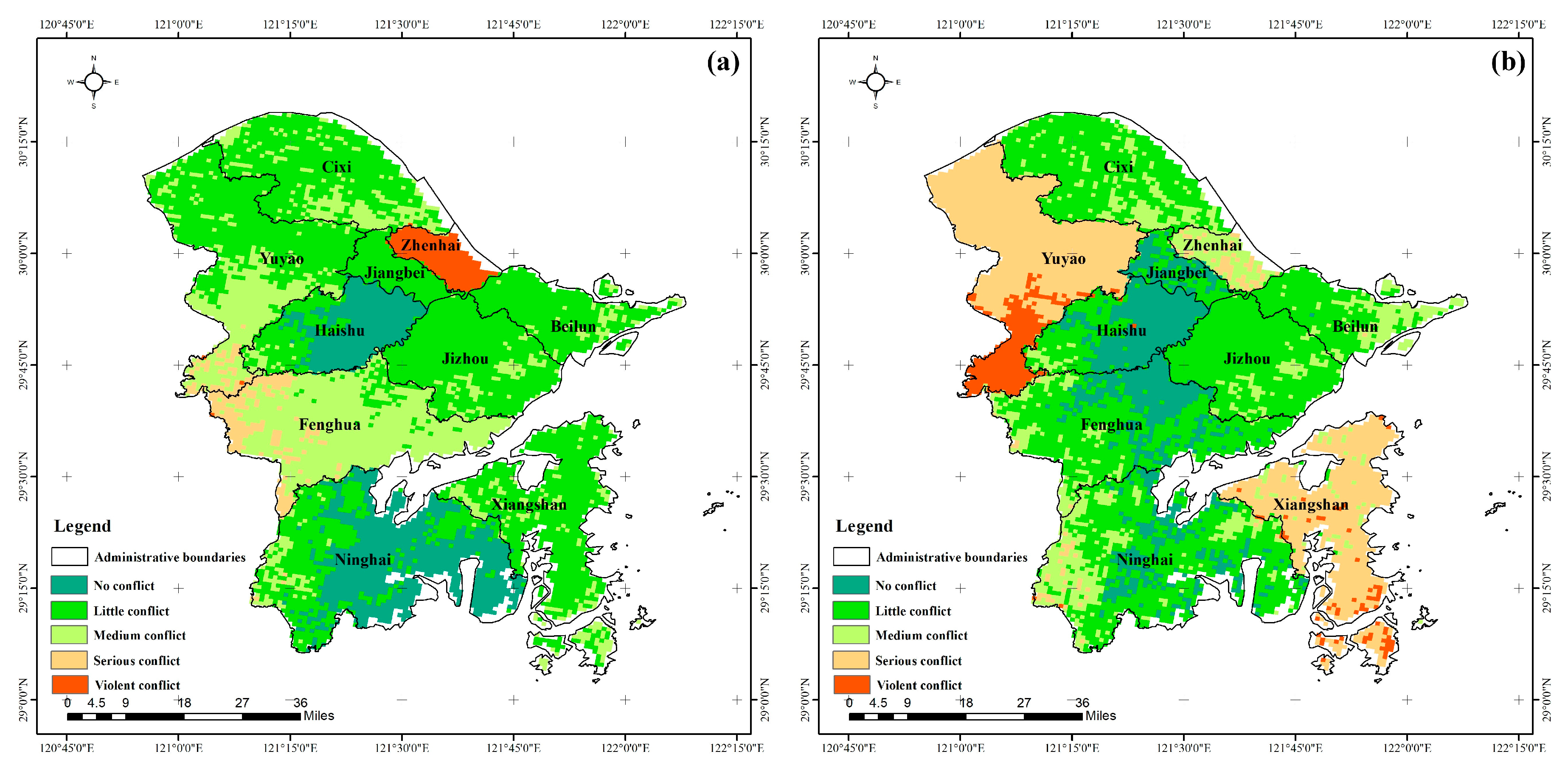Production–Living–Ecological Conflict Identification Using a Multiscale Integration Model Based on Spatial Suitability Analysis and Sustainable Development Evaluation: A Case Study of Ningbo, China
Abstract
1. Introduction
1.1. Motivation and Literature Review
1.2. Objective and Contribution
2. Materials and Methods
2.1. Study Area
2.2. Research Framework
2.3. PLES classification
2.4. Construction of PLES Suitability Evaluation Model on Grid Scale
2.5. Coupling and Coordination Model
2.6. Sustainable Development Evaluation on Administration-Cell Scale
2.7. PLES Conflict Identification Based on Multiscale Integration Model
3. Results and Analysis
3.1. Spatial–Temporal PLES Characteristics in Ningbo
3.2. Coupling and Coordination for PLES Suitability Analysis in Ningbo
3.3. Sustainable Development Evaluation of PLES on Administration-Cell Scale in Ningbo
3.4. PLES Conflict Identification in Ningbo
4. Discussion and Conclusions
Author Contributions
Funding
Institutional Review Board Statement
Informed Consent Statement
Data Availability Statement
Acknowledgments
Conflicts of Interest
References
- Montanari, A.; Londei, A.; Staniscia, B. Can we interpret the evolution of coastal land use conflicts? Using Artificial Neural Networks to model the effects of alternative development policies. Ocean Coast. Manag. 2014, 101, 114–122. [Google Scholar] [CrossRef]
- Tudor, C.A.; Ioja, I.C.; Pǎtru-Stupariu, I.; Nită, M.R.; Hersperger, A.M. How successful is the resolution of land-use conflicts? A comparison of cases from Switzerland and Romania. Appl. Geogr. 2014, 47, 125–136. [Google Scholar] [CrossRef]
- Chapin, F.S.; Díaz, S. Interactions Between Changing Climate and Biodiversity: Shaping Humanity’s Future. PNAS 2020, 117, 6295–6296. [Google Scholar] [CrossRef]
- Shen, Y.; Liu, T.K.; Zhou, P. Theoretical Analysis and Strategies of Natural Ecological Space Use Control. China Land Sci. 2017, 31, 17–24. [Google Scholar]
- Peng, J.; Lv, D.N.; Dong, J.Q.; Liu, Y.X.; Liu, Q.Y.; Li, B. Processes coupling and spatial integration: Characterizing ecological restoration of territorial space in view of landscape ecology. J. Nat. Resour. 2020, 35, 3–13. [Google Scholar]
- Huang, A.; Xu, Y.Q.; Hao, J.M.; Sun, P.L.; Liu, C.; Zheng, W.R. Progress Review on Land Use Functions Evaluation and Its Prospects. China Land Sci. 2017, 31, 88–97. [Google Scholar]
- Adam, Y.O.; Pretzsch, J.; Darr, D. Land use conflicts in central Sudan: Perception and local coping mechanisms. Land Use Policy 2015, 42, 1–6. [Google Scholar] [CrossRef]
- Avriel-Avni, N.; Rofè, Y.; Scheinkman-Shachar, F. Spatial Modeling of Landscape Values: Discovering the Boundaries of Conflicts and Identifying Mutual Benefits as a Basis for Land Management. Soc. Nat. Resour. 2020. [Google Scholar] [CrossRef]
- Maleki, J.; Masoumi, Z.; Hakimpour, F.; Coello, C.A.C. A spatial land-use planning support system based on game theory. Land Use Policy 2020, 99, 105013. [Google Scholar] [CrossRef]
- Yang, S.; Dou, S.B.; Li, C.X. Land-use conflict identification in urban fringe areas using the theory of leading functional space partition. Soc. Sci. J. 2020, 10, 1–16. [Google Scholar] [CrossRef]
- Malczewski, J. GIS-based multicriteria decision analysis: A survey of the literature. Int. J. Geogr. Inf. Sci. 2006, 20, 703–726. [Google Scholar] [CrossRef]
- Demesouka, O.E.; Anagnostopoulos, K.P.; Eleftherios, S. Spatial multicriteria decision support for robust land-use suitability: The case of landfill site selection in Northeastern Greece. Eur. J. Oper. Res. 2018, 272, 574–586. [Google Scholar] [CrossRef]
- Zou, L.; Liu, Y.; Wang, J.; Yang, Y.Y.; Wang, Y.S. Land use conflict identification and sustainable development scenario Simulation on China’s southeast coast. J. Clean. Prod. 2019, 238, 117899. [Google Scholar] [CrossRef]
- Zou, L.L.; Liu, Y.S.; Wang, Y.Y. An analysis of land use conflict potentials based on ecological-production-living function in the southeast coastal area of China. Ecol. Indic. 2021, 122, 107297. [Google Scholar] [CrossRef]
- Yu, S.H.; Deng, W.; Xu, Y.X.; Zhang, X.; Xiang, H.L. Evaluation of the production-living-ecology space function suitability of Pingshan County in the Taihang mountainous area, China. J. Mt. Sci. 2020, 17, 2562–2576. [Google Scholar] [CrossRef]
- Miller, J.A.; Hanham, R.Q. Spatial nonstationarity and the scale of species-environment relationships in the Mojave Desert, California, USA. Int. J. Geogr. Inf. Sci. 2011, 25, 423–438. [Google Scholar] [CrossRef]
- Liang, H.D.; Guo, J.Z.Y.; Wu, J.P.; Chen, Z.Q. GDP spatialization in Ningbo City based on NPP/VIIRS night-time light and auxiliary data using random forest regression. Adv. Space Res. 2020, 65, 481–493. [Google Scholar] [CrossRef]
- Ningbo Municipal Statistics Bureau. Statistical bulletin of national economic and social development of Ningbo in 2020. Ningbo Munic. Stat. Bur. 2021. [Google Scholar]
- Feng, Y.J.; Yang, Q.Q.; Tong, X.H.; Wang, J.F. Long-Term Regional Environmental Risk Assessment and Future Scenario Projection at Ningbo, China Coupling the Impact of Sea Level Rise. Sustainability 2019, 11, 1560. [Google Scholar] [CrossRef]
- Feng, Y.J.; Yang, Q.Q.; Tong, X.H.; Chen, L.J. Evaluating land ecological security and examining its relationships with driving factors using GIS and generalized additive model. Sci. Total Environ. 2018, 633, 1469–1479. [Google Scholar] [CrossRef] [PubMed]
- Li, Y.; Wei, B.Q.; Suo, A.N.; Zhang, Z.F.; Xu, Y.; Liang, Y.H. Spatial and Temporal Coupling Relationships of Coastline Exploitation and Environmental Carrying Safety in Ningbo, China. J. Coast. Res. 2020, 36, 1292–1301. [Google Scholar] [CrossRef]
- Xu, X.L.; Liu, J.Y.; Zhang, S.W.; Li, R.D.; Yan, C.Z.; Wu, S.X. Multi Period Land Use and Land Cover Remote Sensing Monitoring Data Set in China (CNLUCC). 2018. Available online: http://www.resdc.cn/DOI (accessed on 25 January 2021).
- Cui, J.X.; Kong, X.S.; Chen, J.; Sun, J.W.; Zhu, Y.Y. Spatially Explicit Evaluation and Driving Factor Identification of Land Use Conflict in Yangtze River Economic Belt. Land 2021, 10, 43. [Google Scholar] [CrossRef]
- Zhou, D.; Lin, Z.L.; Lim, S.H. Spatial characteristics and risk factor identification for land use spatial conflicts in a rapid urbanization region in China. Environ. Monit. Assess. 2019, 191, 677. [Google Scholar] [CrossRef] [PubMed]
- Wassenaar, T.; Gerber, P.; Verburg, P.H.; Rosales, M.; Ibrahim, M.; Steinfeld, H. Projecting land use changes in the Neotropics: The geography of pasture expansion into forest. Glob. Environ. Chang. 2007, 17, 86–104. [Google Scholar] [CrossRef]
- Jiang, S.; Meng, J.; Zhu, L. Spatial and temporal analyses of potential land use conflict under the constraints of water resources in the middle reaches of the Heihe River. Land Use Policy 2020, 97, 104773. [Google Scholar] [CrossRef]
- Xiao, L.L.; Liu, Q.Q.; Yu, H.; Lin, M.S. Community regulation in national park based on land use conflict identification: A case study on Qianjiangyuan National Park. Acta Ecol. Sin. 2020, 40, 7277–7286. [Google Scholar]
- Jiang, L.; Bai, L.; Wu, Y.M. Coupling and Coordinating Degrees of Provincial Economy, Resources and Environment in China. J. Nat. Resour. 2017, 32, 788–799. [Google Scholar]
- Lu, H.; Zhou, L.; Chen, Y.; An, Y.; Hou, C. Degree of coupling and coordination of eco-economic system and the influencing factors: A case study in Yanchi County, Ningxia Hui Autonomous Region, China. J. Arid Land 2017, 9, 446–457. [Google Scholar] [CrossRef]
- Zhang, Z.F. Sustainable Land Use Goals, Challenges and Countermeasures in China for SDGs. China Land Sci. 2019, 33, 48–55. [Google Scholar]
- Zhang, X.S.; Xu, Z.J. Functional Coupling Degree and Human Activity Intensity of Production–Living–Ecological Space in Underdeveloped Regions in China: Case Study of Guizhou Province. Land 2021, 10, 56. [Google Scholar] [CrossRef]
- Lu, C.Y.; Li, L.; Lei, Y.F.; Ren, C.Y.; Su, Y.; Huang, Y.F.; Chen, Y.; Lei, S.H.; Fu, W.W. Coupling Coordination Relationship between Urban Sprawl and Urbanization Quality in the West Taiwan Strait Urban Agglomeration, China: Observation and Analysis from DMSP/OLS Nighttime Light Imagery and Panel Data. Remote Sens. 2020, 12, 32217. [Google Scholar] [CrossRef]
- Wei, C.; Lin, Q.W.; Yu, L.; Zhang, H.W.; Ye, S.; Zhang, D. Research on Sustainable Land Use Based on Production–Living–Ecological Function: A Case Study of Hubei Province, China. Sustainability 2021, 13, 996. [Google Scholar] [CrossRef]
- Wang, K.; Tang, Y.K.; Chen, Y.Z.; Shang, L.W.; Ji, X.M.; Yao, M.C.; Wang, P. The Coupling and Coordinated Development from Urban Land Using Benefits and Urbanization Level: Case Study from Fujian Province (China). Int. J. Environ. Res. Public Health 2020, 17, 5647. [Google Scholar] [CrossRef] [PubMed]
- Zhu, S.Y.; Diao, C.L.; Xiao, W.B.; Chen, Q.C.; Wang, H. Convenience Index of Public Transportation for Urban Tourist Attraction: Based on Investigation in Wuhan. J. Transp. Syst. Eng. Inf. Technol. 2021, 21, 169–175. [Google Scholar]
- Wan, J.; Zhang, L.W.; Yan, J.P.; Wang, X.M.; Wang, T. Spatial–Temporal Characteristics and Influencing Factors of Coupled Coordination between Urbanization and Eco-Environment: A Case Study of 13 Urban Agglomerations in China. Sustainability 2020, 12, 8821. [Google Scholar] [CrossRef]
- Wang, D.; Jiang, D.; Fu, J.Y.; Lin, G.; Zhang, J.L. Comprehensive Assessment of Production–Living– Ecological Space Based on the Coupling Coordination Degree Model. Sustainability 2020, 12, 2009. [Google Scholar] [CrossRef]
- United Nations. Transforming Our World: The 2030 Agenda for Sustainable Development; United Nations: New York, NY, USA, 2015. [Google Scholar]
- Wang, J.; Fan, X.Y. Assessment of Residents’ Health Level Based on Fuzzy Comprehensive Evaluation. J. Guizhou Univ. 2020, 37, 30–34. [Google Scholar]
- Wang, Z.; Ma, H. Research on Integration Model of Multi-scale Basic Geographic Information Data: Taking Xianyang City as an Example. Geomat. Spat. Inf. Technol. 2019, 42, 150–152. [Google Scholar]





| PLES Classification | Land-Use/-Cover Classification System for Remote-Sensing Monitoring in China [22] | |
|---|---|---|
| PS | Agricultural-production space | Paddy fields, dry land |
| Industrial-production space | Industry and mining, land use for transport construction | |
| LS | Urban-living space | Urban land |
| Rural-living space | Rural residential land | |
| ES | Forestland ecological space | Woodland, shrub land, open forest land, other woodland |
| Grassland ecological space | Grassland with high, medium, and low coverage | |
| Water ecological space | Canals, lakes, reservoir pit ponds, permanent glaciers and snowfields, tidal flats, bottomland | |
| Other ecological space | Sandy land, Gobi, saline alkali land, swamp land, bare land, bare rock land, and other unused land | |
| Items | Index | Factor Classification and Score [14,23,24,25,26,27] | |||
|---|---|---|---|---|---|
| 100 | 80 | 60 | 40 | ||
| Production suitability | Average annual temperature | ≥21 | >18–21 | >15–18 | ≤15 |
| Annual precipitation | ≥1800 | >1700–1800 | >1600–1700 | ≤1600 | |
| Altitude | <150 m | >150–300 m | >300–500 m | >500 m | |
| Land use type | Dry land, paddy field, other construction land | Rural land, urban land | Grassland with high coverage | Others | |
| Gradient | <3° | 3°–8° | 8°–15° | 15°–25° | |
| Distance from road (m) | 500 m | 1500 m | 3000 m | 5000 m | |
| Living suitability | Average annual temperature | ≥21 | >18–21 | >15–18 | ≤15 |
| Annual precipitation | ≥1800 | >1700–1800 | >1600–1700 | ≤1600 | |
| Topographic position index | ≤0.54 | 0.54–0.62 | 0.62–0.72 | ≥0.72 | |
| Distance from town center | 500 m | 1500 m | 3000 m | 5000 m | |
| Distance from school and hospital | 500 m | 1500 m | 3000 m | 5000 m | |
| Land use type | Rural land, urban land | Other construction land | N/A | Others | |
| Ecological suitability | Land use type | Open forest land, grassland with high coverage, swamp land | shrub land, canals, lakes | Dry land, paddy fields, woodland, shrub land, other woodlands, grassland with medium and low coverage, reservoir pit ponds | Rural land, urban land, other construction land, and others |
| Landscape fragmentation | Better regularity | Good regularity | General regularity | Bad regularity | |
| Normalized difference vegetation index (NDVI) | ≥0.5 | >0.25–0.5 | >0.15–0.25 | ≤0.15 | |
| Distance from water body | 5000 m | 3000 m | 1500 m | 500 m | |
| Items | SDGs | First-Level Indices | Second-Level Indices |
|---|---|---|---|
| Production space (intensive and efficient) | SDGs 2 and 12 | Scale of production space | Scale of agricultural land [31] |
| Scale of industrial land [31] | |||
| Structure of production space | Advancement of industrial structure [32] | ||
| Efficiency of production space | Grain output rate [33] | ||
| Land output rate [34] | |||
| Industrial efficiency [34] | |||
| Living space (livable life) | SDGs 1 and 11 | Scale of living space | Size of residential space [31] |
| Quality of living | Green-space coverage ratio [33] | ||
| Engel’s coefficient of urban residents [33] | |||
| Convenience of living | Transportation convenient [35] | ||
| Traffic accessibility [36] | |||
| Ecological space (beautiful ecology) | SDGs 3, 6, 13, and 15 | Scale of ecological space | Scale of ecological land [31] |
| NDVI [37] | |||
| Quality of ecological space | Air quality [38] | ||
| Sewage treatment rate [32] | |||
| Health level of residents [39] |
Publisher’s Note: MDPI stays neutral with regard to jurisdictional claims in published maps and institutional affiliations. |
© 2021 by the authors. Licensee MDPI, Basel, Switzerland. This article is an open access article distributed under the terms and conditions of the Creative Commons Attribution (CC BY) license (https://creativecommons.org/licenses/by/4.0/).
Share and Cite
Lin, G.; Fu, J.; Jiang, D. Production–Living–Ecological Conflict Identification Using a Multiscale Integration Model Based on Spatial Suitability Analysis and Sustainable Development Evaluation: A Case Study of Ningbo, China. Land 2021, 10, 383. https://doi.org/10.3390/land10040383
Lin G, Fu J, Jiang D. Production–Living–Ecological Conflict Identification Using a Multiscale Integration Model Based on Spatial Suitability Analysis and Sustainable Development Evaluation: A Case Study of Ningbo, China. Land. 2021; 10(4):383. https://doi.org/10.3390/land10040383
Chicago/Turabian StyleLin, Gang, Jingying Fu, and Dong Jiang. 2021. "Production–Living–Ecological Conflict Identification Using a Multiscale Integration Model Based on Spatial Suitability Analysis and Sustainable Development Evaluation: A Case Study of Ningbo, China" Land 10, no. 4: 383. https://doi.org/10.3390/land10040383
APA StyleLin, G., Fu, J., & Jiang, D. (2021). Production–Living–Ecological Conflict Identification Using a Multiscale Integration Model Based on Spatial Suitability Analysis and Sustainable Development Evaluation: A Case Study of Ningbo, China. Land, 10(4), 383. https://doi.org/10.3390/land10040383








